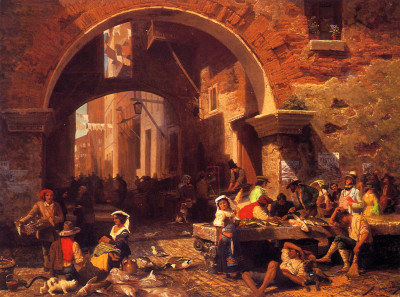Here we find a Roman Fish Market set around the Arch of Octavius. The Portico of Octavia (Porticus Octaviae) stands near the Theatre of Marcellus within the Italian capital and this is a remaining ruin from an earlier piazza.
Many artists have actually visited the porticus in order to sketch its classical architecture, including British Romanticist, JMW Turner, who would have been well known to Bierstadt when he studied the history of landscape painting. Bierstadt's own version was full of life, combining the past and present, with local Romans enjoying a lively day in the fish market. Several long tables are found on the right hand side, with an exciting sociable crowd enjoying their afternoon. A number of animals are dotted around in this chaotic scene, with cats and birds seeking out parts of fish that have been left around in the market. The archway then stands prominently over them, also offering a view through to the surrounding streets.
The architecture allows Bierstadt to introduce lighting effects, with bright light contrasting against the shade beneath the arch. Through the gap we can see many more buildings as well as other residents going about their daily lives. One can imagine that this is where the main market is situated, stretching up and down this narrow street. A number of sellers can be seen, preparing their fish for sale such as cleaning or removing parts which would not be of interest to the buyers. The wall around the Portico of Octavia is well worn, perhaps reminding us of the age of this city, and how the locals were adapting to its historical architecture, re-using remaining parts in new ways as best they could. Romanticist artists would visit Italy in large numbers, finding the climate and architecture well suited to their work.
For those interested in how the Romanticists covered Italian regions, you should look into the work of Turner, who featured Italy in a number of watercolour and oil paintings. He would travel around with a notebook, in a similar manner to Bierstadt, and these sketches would form the basis of his later paintings. Some of the highlights from his career included the likes of Grand Canal Venice, Eruption of Vesuvius and also Ariccia Sunset. He would inspire many of the later artists who followed on afterwards, having helped to really establish landscape painting as a genuine and respected genre, when previously it had been only used as a supporting element to other content, particularly within the Italian Renaissance.




